Director – Hayao Miyazaki – 1988 – Japan – Cert. U – 86m
*****
Two young girls, whose mother is hospitalised, move to the country with their dad, where they encounter a friendly tree spirit – one of the greatest movies ever made, animated or otherwise, is back out in UK and Ireland cinemas on Friday, August 2nd
There’s something about rewatching and reviewing a favourite film you’ve watched numerous times because it’s coming out again in the cinema. And so it is that I dug out my Japanese release DVD (containing those all important, on/offable English subtitles), from those far off days when those seemingly few of us who knew about extraordinarily talented filmmaker Miyazaki thought none of his films would ever see a UK release, and rewatched his wonderful film for the umpteenth time.
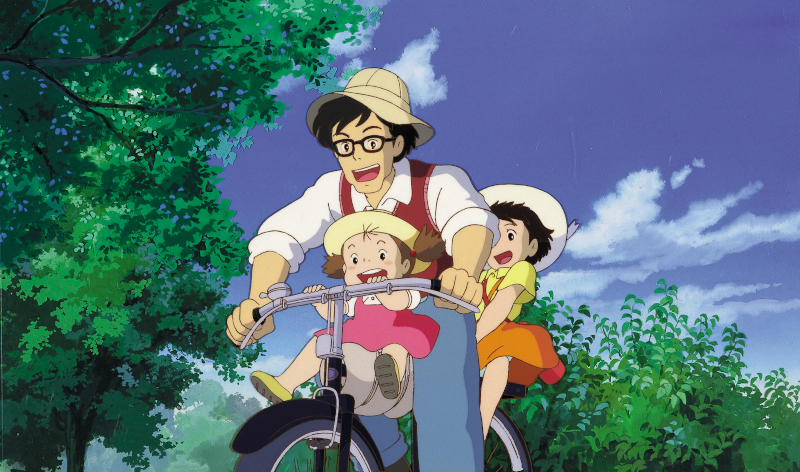
The deceptively simple storyline involves two girls, Satsuki (10 – Japanese voice: Noriko Hidaka; English voice: Dakota Fanning) and Mei (5 – Japanese voice: Chika Sakamoto, English voice: Elle Fanning) who move with their father (Japanese voice: Shigesato Itoi, English voice: Tim Daly) to the countryside to be near the hospital which is looking after their mother (Japanese voice: Sumi Shimamoto, English voice: Lea Salonga). The two girls discover various joys of country living (their father is a university professor, so although it’s never stated, it seems reasonable to assume they know urban rather than country life) and also must contend with news from the hospital which suggests there might be something preventing their mother’s expected recovery. The house in which they are staying is situated near a giant camphor tree, within which dwells the King of the Forest, a giant, furry creature named Totoro. As their father explains to the girls, you can only see him if he lets you.
To the person who’s never seen the film, all the above has the potential to be horribly twee. Yet such is Miyazaki’s grasp of child psychology – this is really a film about two young girls – and family dynamics, and his mastery of both storytelling and the 2D animation medium (in its pre-computer, cel version), that the whole thing proves utterly compelling from start to finish, even if you’ve already seen it numerous times, as this writer has.
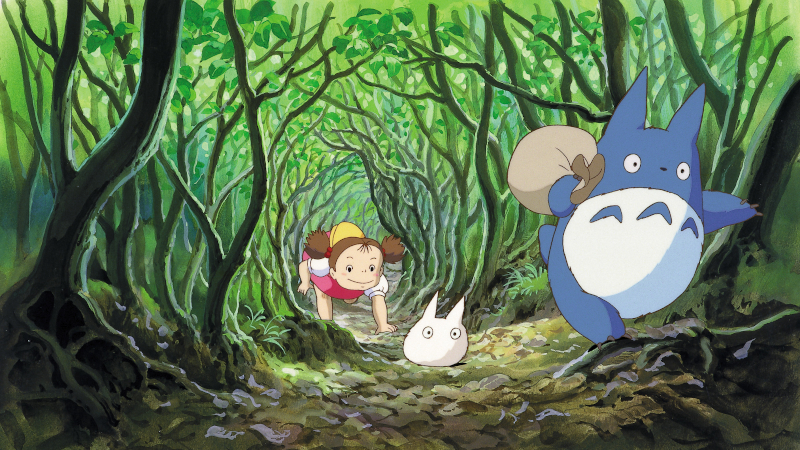
Satsuki is the responsible older sister, trying to do the right thing and be a good big sister to her younger sibling Mei, who she sometimes finds exasperating. Both spend time exploring both the new house and the equally new, to them, great outdoors, but once Satsuki has to go to school, Mei is left to her own devices. Both are struggling to cope with the idea that their mum might not recover from her condition. The old granny (Japanese voice: Tanie Kitabayashi, English voice: Pat Carroll) at the neighbouring house sometimes takes care of both kids, or just Mei when Satsuki is at school; the old lady’s grandson Kanta (about Satsuki’s age; Japanese voice: Toshiyuki Amagasa, English voice: Paul Butcher) is shy around Satsuki and frequently runs away to avoid her.
Mei, playing on her own, spots a little creature maybe six inches high (which we later learn in dialogue to be a little Totoro, the creature being thus named in one of the childrens’ picture books), then another twice that size, and finally – after Mei pursues them through a tunnel of undergrowth and falls down a passage between the camphor tree’s roots (recalling the pursuit down the rabbit hole in Lewis Carroll’s Alice in Wonderland) – finds herself on the furry belly of an enormous, sleeping Totoro (Japanese voice: Hitoshi Tagaki, English voice: Frank Welker) about the height of an elephant.
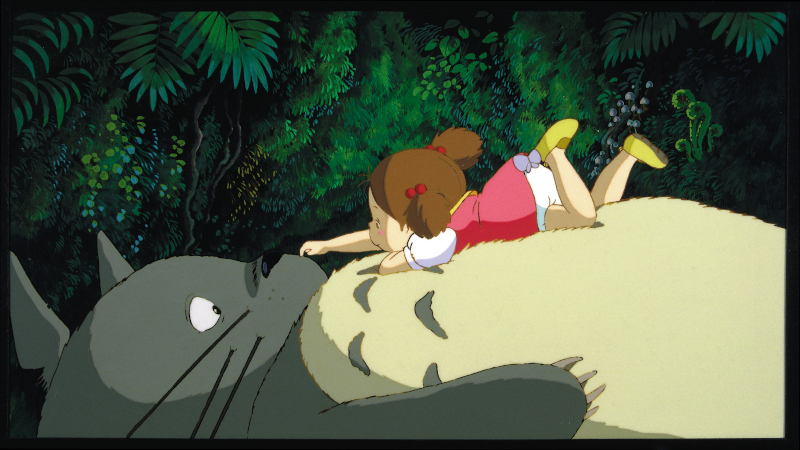
She wakes this large Totoro, and although his size and roar suggest a powerful and potentially fearsome beast, he appears friendly (recalling the “good but not safe” Aslan the Lion in C.S. Lewis’ Narnia books). Totoro’s vast belly has somehow always reminded me of the belly of A.A. Milne’s Winnie-the-Pooh, as illustrated by E.H. Shepherd. These connections are perhaps more than coincidental: there exists a complex relationship between British children’s literature and Japan, as explored in this recent academic book.

This magical scene is followed by several others that are equally memorable. The denouement skilfully leads you up to and into these, engaging you with its characters so that by the time you reach these scenes, you’re completely hooked. The two girls shelter from a thunderstorm at a bus stop under a tree, before being joined by the giant, furry Totoro who waits patiently with them. There follows a visual, comic exchange between the girls and Totoro to rival anything created in silent film by Charlie Chaplin. That’s topped off by the arrival of the bus Totoro is expecting, a fur-covered catbus (Japanese voice: Naoki Tatsuta, English voice: Frank Welker) with multiple legs, which he boards. The catbus will later come to the rescue when Mei, fearful for her mother’s health, decides to take a corn-on-the-cob to her in the hospital, gets lost en route, and has the entire village out looking for her.
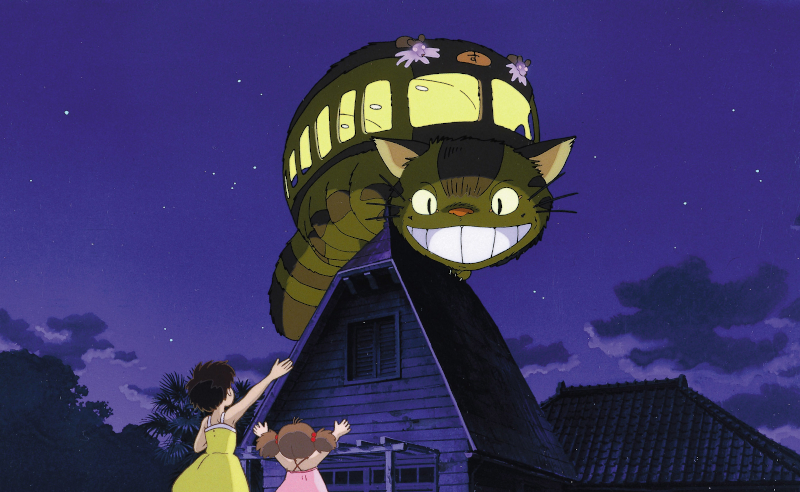
The animation is deceptively simple, yet utterly captivating. Miyazaki knows where to keep the work simple without the audience feeling short-changed, and he knows how to inspire his animation staff to deliver exactly what he wants. Witness the incredible, nighttime sequence where planted seeds, with the aid of ritual dance by the three Totoros and the two girls, grow in a matter of seconds into a vast camphor tree, to the accompaniment of awe-inspiring music. It turns out to be a dream, but somehow it seems no less miraculous that, on awakening the next morning, the seeds they’ve planted in the real world have indeed spouted their first tiny shoots.
The music is by composer Joe Hisaishi, who has scored director Miyazaki’s films since Nausicaä of the Valley of the Wind (1984), as well as a number of other productions from Miyazaki’s production company Studio Ghibli, not to mention some seven films for ‘Beat’ Takeshi Kitano from A Scene At The Sea (1992) to Dolls (2002). Hisasihi’s Totoro score is one of his best, with memorable songs at the opening and close, but also some truly magical incidental music cues in the course of the narrative. When two years ago, the film was successfully adapted into a stage play by the RSC at London’s Barbican, Hisaishi reworked his score for the production to retain the magic.
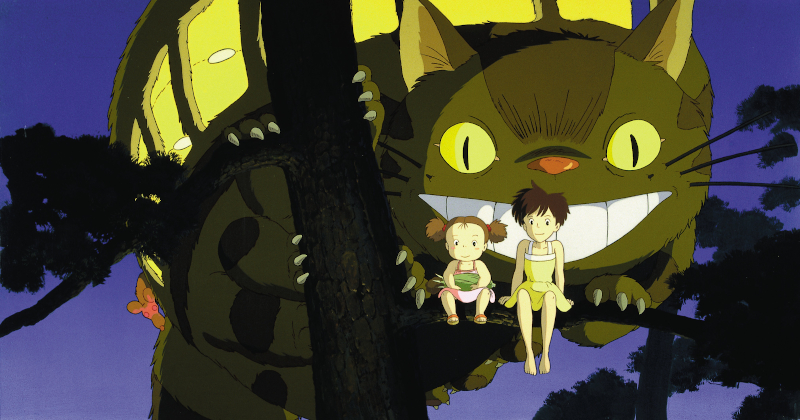
Although huge in Japan in 1988, My Neighbour Totoro never got a UK cinema release at that time. Miyazaki’s films didn’t begin to achieve the international recognition they deserved until Princess Mononoke (1997) and Spirited Away (2001), the latter currently the subject of another London staqe adaptation. Yet, for this writer, Totoro remains not only Miyazaki’s finest achievement, not only one of the best children’s films ever made, not only one of the greatest animated feature films ever, but among the greatest movies of all time. A chance to see it on a big screen at your local cinema is therefore one not to be missed.
My Neighbour Totoro is back out in cinemas in the UK and Ireland on Friday, August 2nd. It is being shown in both Japanese with English subtitles and English language dubbed. I would personally recommend the subtitled version, although the dubbed version is well done. Make sure you check the cinema beforehand to see the version you want to see.
Trailer:
Social channels as follows:
Facebook: ghibliuk
Instagram: @ghibliuk
Twitter/X : @ghibliuk
